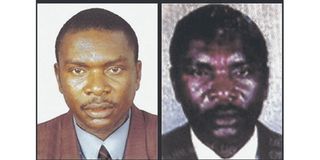Death of key fugitive in Rwanda genocide revealed 16yrs later

This file undated handout shows a combination of pictures released by The United Nations - International Residual Mechanism for Criminal Tribunals (MICT) of Protais Mpiranya who commanded the guard of Rwanda's former president Juvenal Habyarimana at an undisclosed location. PHOTO | AFP
What you need to know:
- Protais Mpiranya, the fugitive most wanted by the justice system for his role in the 1994 genocide of Tutsi in Rwanda, died in 2006, UN prosecutors investigating the case said on May 12, 2022
- He is alleged to be the mastermind of the 1994 genocide in Rwanda in which nearly one million people were hacked to death.
Arusha. Until recently, he was one of the hunted persons on earth with a $5 million bounty on his head.
He is alleged to be the mastermind of the 1994 genocide in Rwanda in which nearly one million people were hacked to death.
Like several alleged people who played a big role in the massacre, he fled and went into hiding outside his motherland.
His whereabouts remained mystery although the UN investigators and the Rwanda officials believed he was in Zimbabwe.
And as late as June last year, investigators from the International Residual Mechanism for Criminal Tribunals (Mechanism) were in Harare to track him down.
On Thursday, the Arusha-based Tribunal announced that Protais Mpiranya, indeed, passed away in 2006; some 16 years ago in Zimbabwe.
Confirmation of his death brings down the number of outstanding fugitives indicted for the killings that shocked the world.
Mpiranya was before the genocide the commander of the Presidential Guard of Juvenal Habyarimana’s government.
He was indicted by the International Criminal Tribunal for Rwanda (ICTR) -which has since been disbanded to pave way for Mechanism- in 2000.
Like most of the suspects - on the run or convicted - he was charged with genocide, complicity in genocide, crimes against humanity and war crimes.
He was charged with responsibility in the killing of former Rwanda prime minister Agathe Uwilingimana and 10 Belgian UN peacekeepers. After the publication of his indictment (in 2000), he fled to Zimbabwe in 2002 until his death on October 5, 2006.
Officials at the Mechanism facility in Arusha could not say why it has taken so long for his death to be confirmed.
A statement to the media only said the investigations were challenging and intensive but finally determined that he died in October 2006.
“His death could have been deliberately concealed by concerted efforts of his family and associates,” the statement said.
However, the late confirmation of a key suspect in the genocide against the Tutsi is not entirely surprising for observers following up the matter. It took the UN Tribunal 20 years to confirm the death of Augustine Bizimana, the former Rwandan Defence minister who was also indicted by the Court.
He died in Congo-Brazzaville in 2000 but it was not until the middle of 2020 that he was officially announced to have died.
In such a scenario, the confirmation is made after DNA analysis and according to the release, that was what was done on Mpiranya’s remains.
The Mechanism Chief Prosecutor Mr Serge Brammertz said the facility was relieved because of the recent gains in arresting the fugitives still on the run.
It was in May 2020, that the Tribunal made a milestone after arresting Felicien Kabuga, the alleged key suspect alleged to have financed the genocide.
He was tracked down in a Paris suburb flat after being on the run for 25 years. He was among those indicted by the ICTR.
Further information had it that the late Mpiranya took an assumed name in Zimbabwe; Sambao Ndume.
After years of stalling the search, the Zimbabwe authorities agreed to allow the digging of the grave on April 27 in the presence of pathologists, UN trackers and detectives.
After the body was exhumed, Mpiranya’s identity was confirmed by DNA analysis early this week, the Mechanism sources said.




